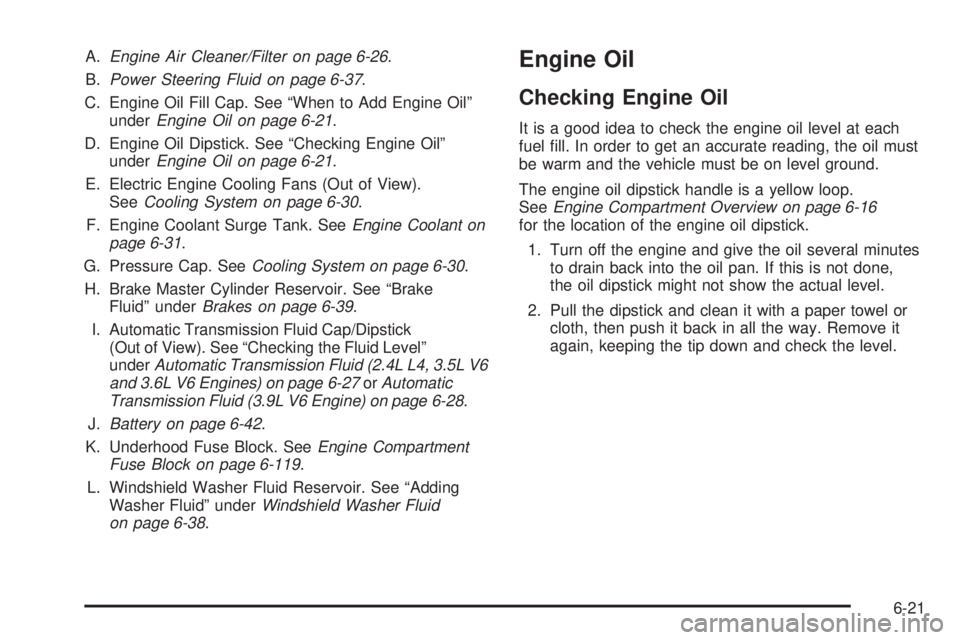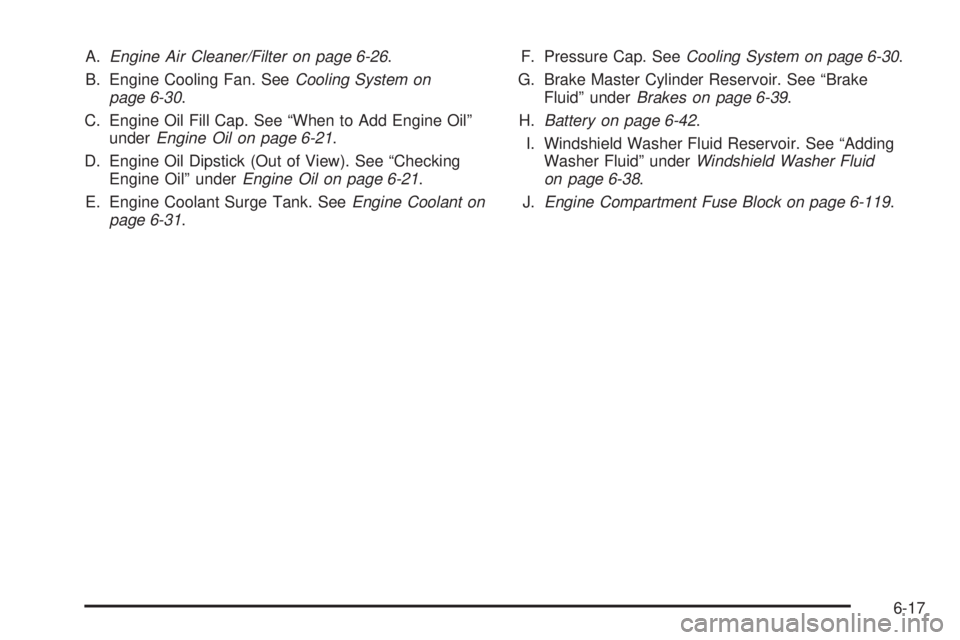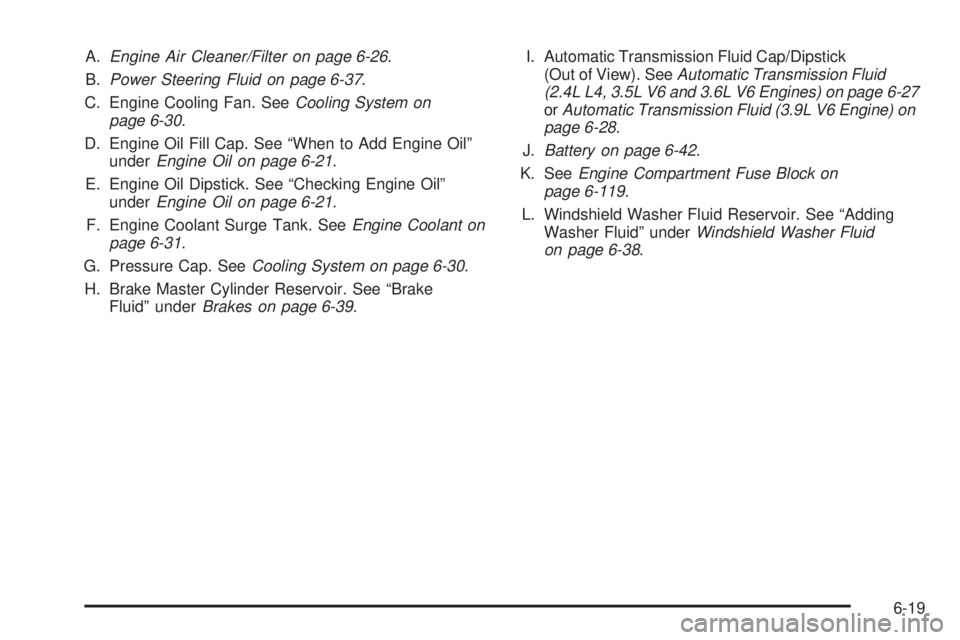PONTIAC G6 2010 Owners Manual
G6 2010
PONTIAC
PONTIAC
https://www.carmanualsonline.info/img/50/40821/w960_40821-0.png
PONTIAC G6 2010 Owners Manual
Trending: brake sensor, gas type, audio, change time, remote start, maintenance, stop start
Page 281 of 448

{WARNING:
If a fire starts while you are refueling, do not
remove the nozzle. Shut off the flow of fuel by
shutting off the pump or by notifying the station
attendant. Leave the area immediately.
Notice:If you need a new fuel cap, be sure to get
the right type. Your dealer/retailer can get one
for you. If you get the wrong type, it may not �t
properly. This may cause the malfunction indicator
lamp to light and may damage the fuel tank and
emissions system. SeeMalfunction Indicator Lamp
on page 4-34.
Filling a Portable Fuel Container
{WARNING:
Never fill a portable fuel container while it is in
the vehicle. Static electricity discharge from the
container can ignite the fuel vapor. You can be
badly burned and the vehicle damaged if this
occurs. To help avoid injury to you and others:
•Dispense fuel only into approved containers.
•Do not fill a container while it is inside a
vehicle, in a vehicle’s trunk, pickup bed,
or on any surface other than the ground.
•Bring the fill nozzle in contact with the inside
of the fill opening before operating the nozzle.
Contact should be maintained until the filling
is complete.
•Do not smoke while pumping fuel.
•Do not use a cellular phone while
pumping fuel.
6-13
Page 282 of 448
Checking Things Under
the Hood
{WARNING:
An electric fan under the hood can start up and
injure you even when the engine is not running.
Keep hands, clothing, and tools away from any
underhood electric fan.
{WARNING:
Things that burn can get on hot engine parts and
start a fire. These include liquids like fuel, oil,
coolant, brake fluid, windshield washer and other
fluids, and plastic or rubber. You or others could
be burned. Be careful not to drop or spill things
that will burn onto a hot engine.
6-14
Page 283 of 448
Hood Release
To open the hood:
1. Pull the handle with
this symbol on it. It is
located under the
instrument panel on
the driver side of the
vehicle.
2. Then go to the front of the vehicle and push the
secondary hood release lever to the right.
3. Lift the hood, release the hood prop rod from its
retainer, and put the hood prop into the slot in the
hood marked with an arrow.
Before closing the hood, be sure all the filler caps are on
properly. Then lift the hood to relieve pressure on the
hood prop. Remove the hood prop from the slot in the
hood and return the prop to its retainer. Then let the
hood down and close it firmly.
6-15
Page 284 of 448
Engine Compartment Overview
When the hood on the 2.4 L L4 engine is opened:
6-16
Page 285 of 448
A.Engine Air Cleaner/Filter on page 6-26.
B. Engine Cooling Fan. SeeCooling System on
page 6-30.
C. Engine Oil Fill Cap. See “When to Add Engine Oil”
underEngine Oil on page 6-21.
D. Engine Oil Dipstick (Out of View). See “Checking
Engine Oil” underEngine Oil on page 6-21.
E. Engine Coolant Surge Tank. SeeEngine Coolant on
page 6-31.F. Pressure Cap. SeeCooling System on page 6-30.
G. Brake Master Cylinder Reservoir. See “Brake
Fluid” underBrakes on page 6-39.
H.Battery on page 6-42.
I. Windshield Washer Fluid Reservoir. See “Adding
Washer Fluid” underWindshield Washer Fluid
on page 6-38.
J.Engine Compartment Fuse Block on page 6-119.
6-17
Page 286 of 448
When the hood on the 3.5 L V6 engine (3.9 L V6 similar) is opened:
6-18
Page 287 of 448
A.Engine Air Cleaner/Filter on page 6-26.
B.Power Steering Fluid on page 6-37.
C. Engine Cooling Fan. SeeCooling System on
page 6-30.
D. Engine Oil Fill Cap. See “When to Add Engine Oil”
underEngine Oil on page 6-21.
E. Engine Oil Dipstick. See “Checking Engine Oil”
underEngine Oil on page 6-21.
F. Engine Coolant Surge Tank. SeeEngine Coolant on
page 6-31.
G. Pressure Cap. SeeCooling System on page 6-30.
H. Brake Master Cylinder Reservoir. See “Brake
Fluid” underBrakes on page 6-39.I. Automatic Transmission Fluid Cap/Dipstick
(Out of View). SeeAutomatic Transmission Fluid
(2.4L L4, 3.5L V6 and 3.6L V6 Engines) on page 6-27
orAutomatic Transmission Fluid (3.9L V6 Engine) on
page 6-28.
J.Battery on page 6-42.
K. SeeEngine Compartment Fuse Block on
page 6-119.
L. Windshield Washer Fluid Reservoir. See “Adding
Washer Fluid” underWindshield Washer Fluid
on page 6-38.
6-19
Page 288 of 448
When the hood on the 3.6 L V6 engine is opened:
6-20
Page 289 of 448

A.Engine Air Cleaner/Filter on page 6-26.
B.Power Steering Fluid on page 6-37.
C. Engine Oil Fill Cap. See “When to Add Engine Oil”
underEngine Oil on page 6-21.
D. Engine Oil Dipstick. See “Checking Engine Oil”
underEngine Oil on page 6-21.
E. Electric Engine Cooling Fans (Out of View).
SeeCooling System on page 6-30.
F. Engine Coolant Surge Tank. SeeEngine Coolant on
page 6-31.
G. Pressure Cap. SeeCooling System on page 6-30.
H. Brake Master Cylinder Reservoir. See “Brake
Fluid” underBrakes on page 6-39.
I. Automatic Transmission Fluid Cap/Dipstick
(Out of View). See “Checking the Fluid Level”
underAutomatic Transmission Fluid (2.4L L4, 3.5L V6
and 3.6L V6 Engines) on page 6-27orAutomatic
Transmission Fluid (3.9L V6 Engine) on page 6-28.
J.Battery on page 6-42.
K. Underhood Fuse Block. SeeEngine Compartment
Fuse Block on page 6-119.
L. Windshield Washer Fluid Reservoir. See “Adding
Washer Fluid” underWindshield Washer Fluid
on page 6-38.Engine Oil
Checking Engine Oil
It is a good idea to check the engine oil level at each
fuel fill. In order to get an accurate reading, the oil must
be warm and the vehicle must be on level ground.
The engine oil dipstick handle is a yellow loop.
SeeEngine Compartment Overview on page 6-16
for the location of the engine oil dipstick.
1. Turn off the engine and give the oil several minutes
to drain back into the oil pan. If this is not done,
the oil dipstick might not show the actual level.
2. Pull the dipstick and clean it with a paper towel or
cloth, then push it back in all the way. Remove it
again, keeping the tip down and check the level.
6-21
Page 290 of 448
When to Add Engine Oil
If the oil is below the MIN mark for the L4 engine or
below the cross-hatched area at the tip of the dipstick
for the V6 engine, add at least one quart/liter of the
recommended oil. This section explains what kind of oil
to use. For engine oil crankcase capacity, seeCapacities
and Speci�cations on page 6-125.Notice:Do not add too much oil. If the engine
has so much oil that the oil level gets above the
upper mark that shows the proper operating range,
the engine could be damaged.
SeeEngine Compartment
Overview on page 6-16
for the location of the
engine oil fill cap.
Add enough oil to put the level somewhere in the proper
operating range. Push the dipstick all the way back in
when through. L4 Engine
V6 Engine
6-22
Trending: remote control, instrument panel, winter tires, fuel filter location, fuel type, wiper blades, oil reset









